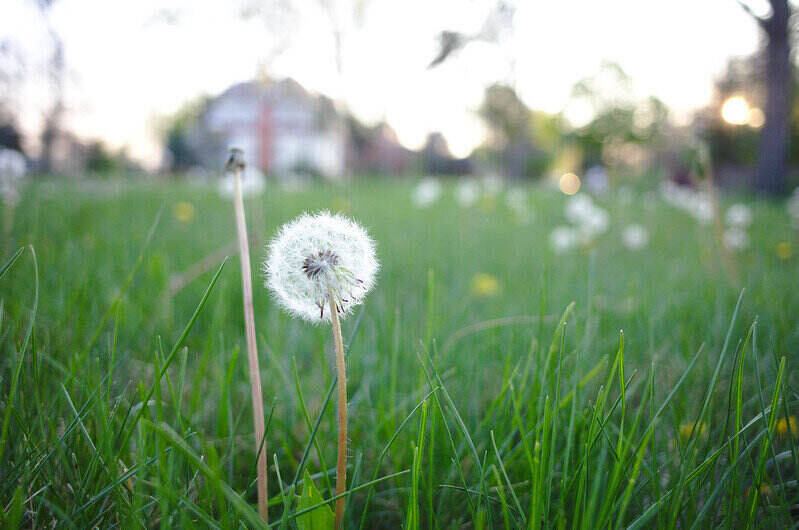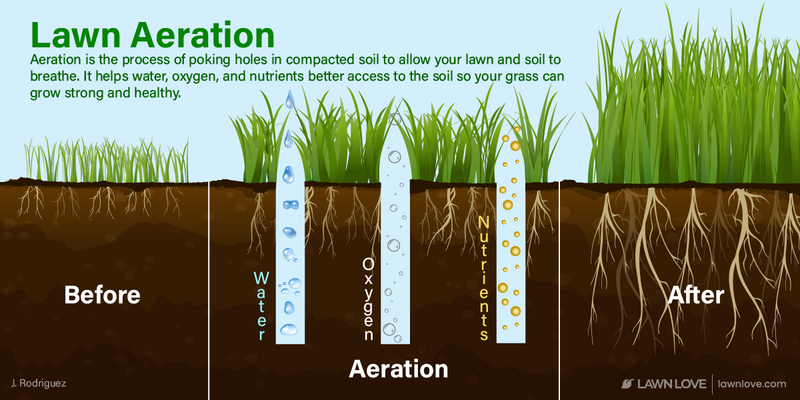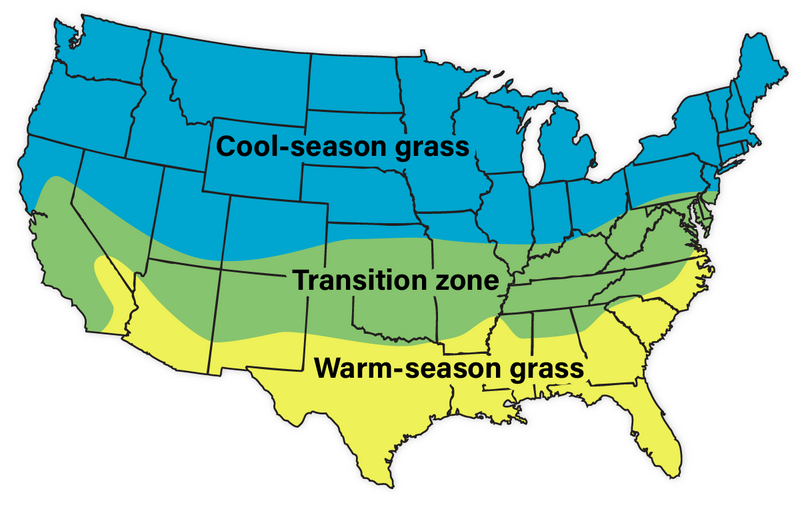
If you’re so over your overgrown weeds, you’re not alone. Weeds are a frustrating and time-consuming part of lawn maintenance. But with a little work, you can gain the upper hand on the weeds in your lawn.
How to get rid of overgrown weeds
Before you get out the weed eater, it’s important to know a few things about your lawn and your weeds.
Know your weeds

A wise warrior once said, “Keep your friends close and your enemies closer.” Strangely, this also applies to weeds. If you don’t know what type of weeds you’re dealing with, take a photo and send it to your local Cooperative Extension office. Or, upload the pic to your favorite plant ID app (PictureThis, Google Lens, PlantNet, etc.) to get a positive ID.
Why is this important? Dormant weed seeds can live in the soil for years or decades. (No, this is not an exaggeration.) So, chances are there is more of what you’re cutting down waiting to germinate. If you know what type of weed you have, you can research the best treatment methods to prevent these weeds from sprouting or treat them in the future.
Know your soil
Much of good lawn care comes in prevention and regular maintenance. Part of that regular care is taking a soil test every few years.
Here’s how to take a soil test in a jiffy:
- Gather a trowel or soil probe and a bucket. (Stainless steel, chrome-plated, or plastic, please — no galvanized, brass, or bronze tools. Also, they must be completely clean.)
- If you’re sampling a lawn, use your digging tool to take six to eight samples 4 inches deep across the lawn. Using a zig zag pattern may be helpful. When you take the sample, put the entire 4-inch depth, from the soil surface to the 4-inch mark, into the bucket.
- When you’ve taken all of your samples, remove anything that is not dirt from the bucket — leaves, grass, sticks, etc.
- If your soil is moist, spread it on a paper bag to dry overnight.
- Ask your Cooperative Extension office how much soil they need. It’s usually around two cups.
- Fill out the form, and wait for your results.
A soil test is like a blood test for your lawn. The only way to know what’s there is to test it. If you haven’t done this in a while, do it now while lawn care is on your mind.
Why is this important? If you don’t know your soil nutrient levels or pH, you won’t know how to improve the soil (which helps grass grow thicker and outcompete weeds). A good soil test will send you a report that includes results and recommendations for how much fertilizer (nitrogen, phosphorus, and potassium) and lime to apply. Your local Cooperative Extension office will send your soil to the state lab, usually for a small fee.
Know what your weeds are telling you (AKA read your weeds)
While you’re waiting for your soil test results to come back, let’s look at how your weeds can function as their own soil test in your lawn.
Weeds are a great indicator species, meaning they like to grow in certain conditions. Think of them as a symptom of a larger problem: If something is out of balance in your lawn, they will let you know. If you correct these imbalances, the existing weeds should die over time and fewer should appear next season.
Weeds that indicate compacted soil: Chickweed, plantain, white clover, pigweed, dallisgrass, burdock, stinging nettle, dandelion
Weeds that indicate acidic soil: Moss, sorrel, buttercup, plantain
Weeds that indicate low fertility soil: Plantain, dandelion, white clover, crabgrass, thistle, carpetgrass, yarrow
Weeds that indicate high fertility soil: Lamb’s quarter, stinging nettle, chickweed, pigweed, purslane
If you have just one species of weed, it may be hard to diagnose your soil. If you have multiple species that all indicate one condition — acidic soil, for example — that may be a good indicator that your soil test will come back positive for that condition. Always get a soil test to be sure.
Know your compaction level

Another part of knowing your soil is to know whether it tends to be too compacted. When you’re building a home or doing construction, you want your soil to have the proper amount of compaction. (Has anyone ever told you not to build your house on the shifting sand?)
But when you’re trying to grow grass, you need a certain amount of pore space in the soil so nutrients, water, and air can circulate.
How do you know if your soil is too compacted? Grab a screwdriver or a sharp knife. If you can’t stick the tool in the soil with only light pressure, you may have compacted soil. (Do this when the soil is moderately moist for an accurate reading.)
If you have compacted soil, aeration is your best bet. To core aerate your lawn is to use a machine that will open up your soil so that nutrients, water, and air circulate better. This leads to stronger roots and healthier grass that outcompetes stubborn weeds.

Putting your knowledge into action
Now that you know a little more about your weeds and your soil, it’s much easier to formulate an effective plan. Here are a few scenarios and how you can correct them:
Weeds next to a curb or driveway
Has the crabgrass overtaken the area next to your curb or driveway? This is very common. The soil next to concrete areas is often compacted, shallow, and warm. These are prime conditions for weeds to pop up.
If you have relatively small areas that are overgrown with a particular weed, you can focus on just that area. Try cultural measures first. If the weed is crabgrass, for example, the underlying problem may be low fertility, mowing too low, and either drought or excessive water. That, combined with a thin stand of grass, makes for prime crabgrass real estate.
For small patches of weeds throughout the lawn, many homeowners will choose to get out a common weed killer like Roundup (glyphosate) and a sprayer and spot-treat. Remember that spot treating should be used in conjunction with good lawn care maintenance for the best long-term results.
If you have a section of lawn where there are more weeds than grass (like crabgrass against a curb), you may need to do a renovation.
Mow down the crabgrass seeds
Set your lawn mower to the lowest setting and bag the grass clippings. Toss the clippings in the trash or city green waste bin when you’re done. This removes as much of the crabgrass as possible. (Such a low mowing height may not be advisable with other types of weeds.)
Aerate or use a dethatching machine

This may not be needed in all lawns, but if you have compacted soils or heavy thatch, this will help prepare a nice bed of soil for your grass seed. (Thatch is a layer of plant material between the grass and the soil. If it gets over about ½ inch, it will prevent air, water, and fertilizer from reaching the soil.)
Add compost
Compost adds organic matter to the soil and builds up areas with thin soil. Use the back of a landscape rake to level out the compost.
Add fertilizer
Starter fertilizer will ensure your new grass has the nutrients it needs for strong growth.
Spread the grass seed
Put the new seed in a spreader. Use the amount recommended on the bag. Too much or too little grass seed leads to an unhealthy patch of grass.
Press the seed into the compost
Use the back of a rake to press the new grass seed into the bed of compost.
Water
Water once or twice per day to keep the soil moist — not soggy.
If other areas of your lawn are dotted with the same weed, consider using a natural or chemical pre-emergent before they sprout next season. The easiest way to deal with persistent weeds is to prevent them from sprouting in the first place.
When should I plant new grass? In areas of the country with warm-season grass (or the southern transition zone), plant grass seed in late spring or early summer. In areas of the country with cool-season grass (or the upper transition zone), plant grass seed in late summer or early fall.

Weeds in flower beds
Even with a base layer of landscape fabric or mulch, weeds may still take up residence in your flower beds. Here are a few tips to evict these weeds:
- Get out your garden hoe or hand-pull.
- Put in a new layer of mulch. This will help prevent next season’s weeds from landing on bare soil.
- A propane weed torch is another effective tool in the fight against flower bed weeds.
- If you would rather use commercial herbicides, check out the best weed killers for flower beds.
Weeds in the garden
You know how easy it is for thin lawns to host weeds. Garden beds, which have no perennial ground cover, are just that much more susceptible to weeds.
Here are a few ways to manage weeds naturally in your garden:
Whether you do organic gardening or not, many homeowners prefer natural weed control options in a home food garden.
Spray the weeds

Spraying with horticultural vinegar or a store-bought organic spray can help control weeds in your garden area.
Deprive them of sunlight
Cover crop residue, cardboard, or wood chips prevent sunlight from reaching the weed seeds buried in the soil.
Weed eat the area
Using a weed eater is a quick way to keep the weeds in and around your garden plot knocked down. This also prevents seed-bearing weeds from setting seeds. Note: Depending on where you live, you may know these as string trimmers, strimmers, or weed whackers, among other things.
Torch the weeds
If you have unruly weeds next to your metal garden fence posts, a propane weed torch is a good option. Be sure to keep the heat away from the plants you want to keep.
Overgrown “jungle lawn”
If you can see Tarzan swinging from the trees, you’ve got some work ahead of you. This situation is not what most homeowners face, but if you buy an abandoned property, this is common.
What you’ll need to do is hire someone to knock down the jungle so you can have a clear line of sight and see the ground again. Most residential lawn equipment is not suited for extremely overgrown grass and saplings. This is a job for the pros.
Once you can see the ground again, you can get a soil test, determine whether you have any grass at all, and plant a brand new lawn. If you’re looking for an ultra low-maintenance lawn, consider planting a grass alternative.
FAQ
You can take a soil test at any time of the year. But it is best to take the sample the season before you plan to do any major work in the lawn. This is because your results will make recommendations for the following growing season.
In most home lawns, weeds are treated as a nuisance and not the desirable plants you want in your lawn. This is understandable. After all, you have a vested interest in your lawn (and in some cases, so does your HOA).
Having said that, if you step outside of the “perfect lawn” box for a moment, weeds, as plants in their own right, are a fascinating topic. Stinging nettles, for example, make a high-quality all-purpose fertilizer (soak them in a bucket of water for one to two weeks), and many common weeds are edible.
In addition to their uses as fertilizer and food, weeds have a long history of use as medicine.
Whether you have broadleaf, grassy, annual, or perennial weeds, the best way to prevent weeds is to have a healthy, dense lawn. Weeds like crabgrass, for example, can’t germinate without sunlight. If you have a dense lawn and mow your grass at the proper height (to shade the soil), you’ll have much less crabgrass over time.
Simple, routine lawn maintenance activities like overseeding bare patches, aerating regularly if you have heavy soil, watering at the right time, and mowing at the right height are key. Maintaining a lawn is hard work, and you won’t have a weed-free lawn overnight. With persistence, though, you’ll see fewer weeds each season.
If pulling weeds is a stressful rather than relaxing activity, opt for Plan B: Call one of our local lawn care pros. They know how to knock down your weeds and get your lawn back on track.
Main Photo Credit: Daniel Tuttle | Unsplash